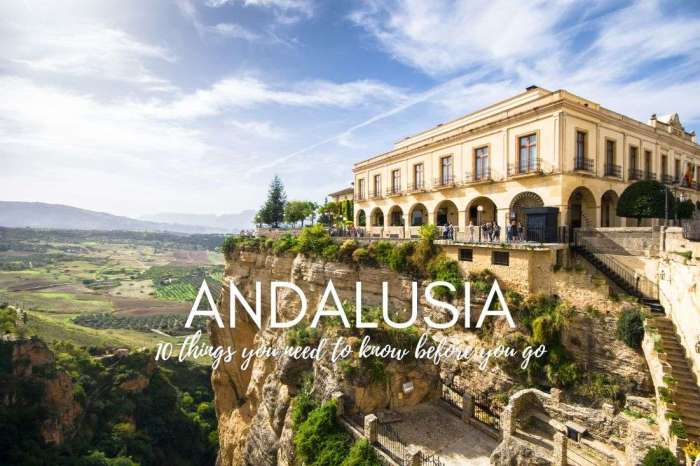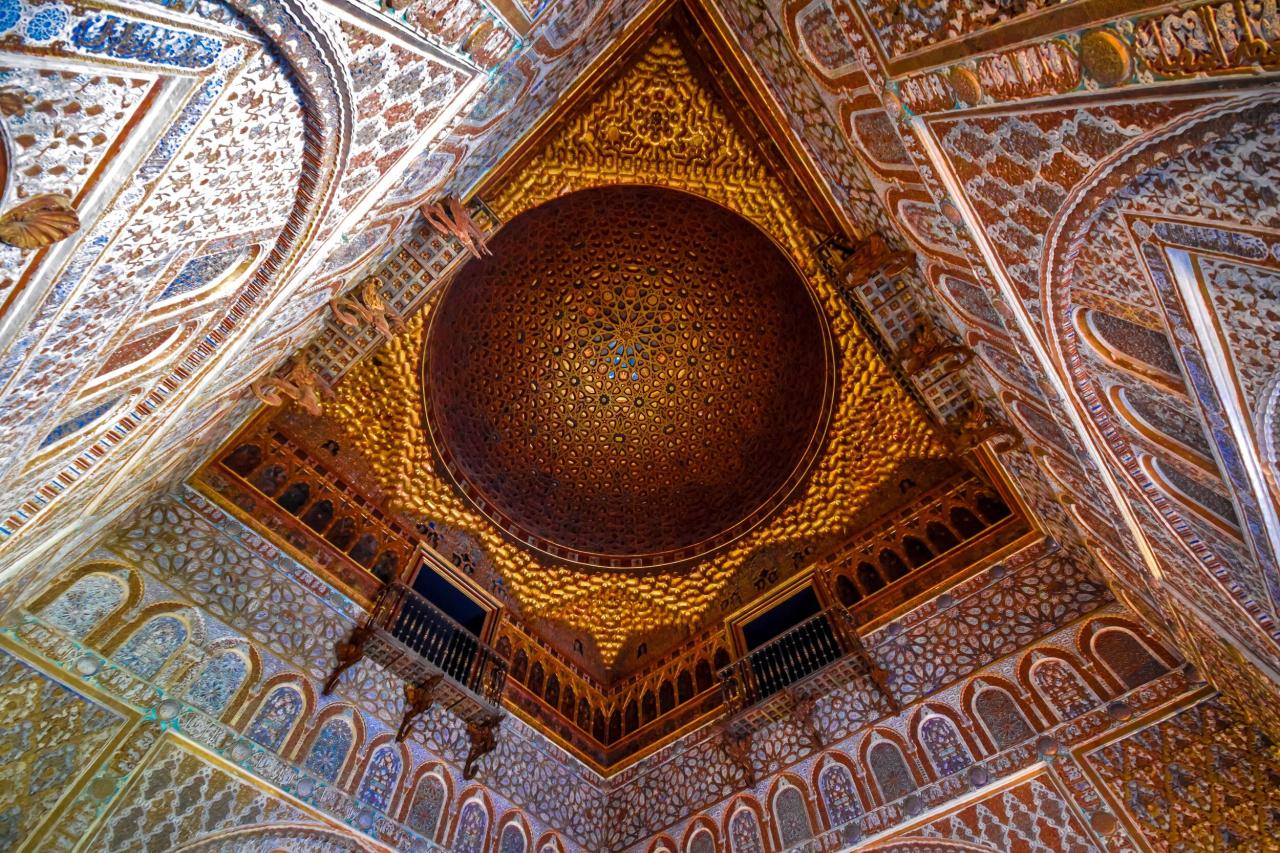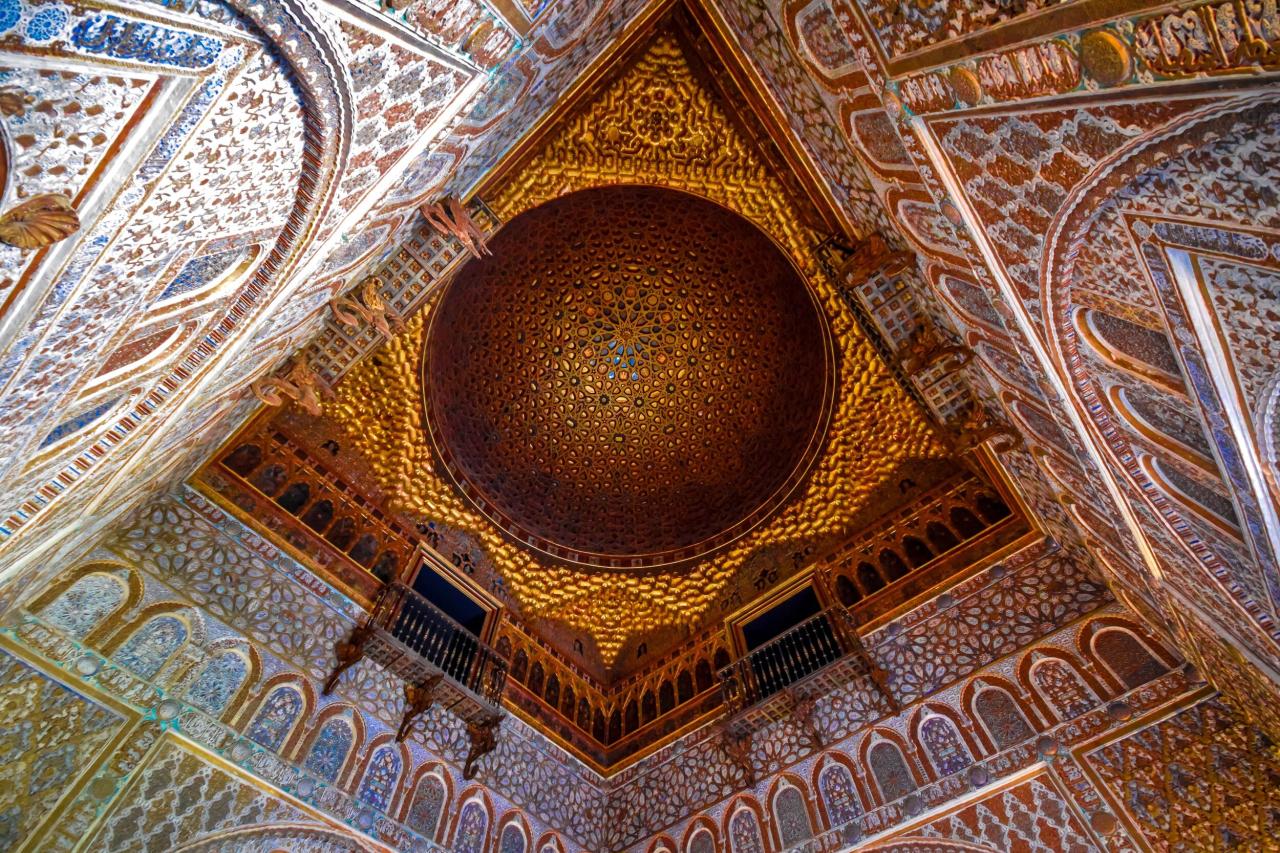Expert guide to Andalusia Spain takes you on a captivating journey through this sun-drenched region of Spain. From its rich history and vibrant culture to its stunning landscapes and delicious cuisine, Andalusia promises an unforgettable experience. This comprehensive guide dives deep into the heart of Andalusia, providing essential insights and practical tips to help you plan your dream trip.
This expert guide will cover everything from the best time to visit and essential destinations to local customs, cuisine, and transportation. Prepare to be captivated by the flamenco rhythms, the Moorish architecture, and the warm hospitality that defines this enchanting region.
Introduction to Andalusia
Andalusia, the southernmost region of Spain, is a captivating blend of vibrant culture, rich history, and breathtaking landscapes. From the ancient Moorish palaces to the sun-drenched beaches, it offers a unique experience for travelers seeking adventure, relaxation, and cultural immersion. The region’s allure lies in its ability to seamlessly intertwine historical grandeur with modern-day charm, creating an unforgettable journey through time.Andalusia’s unique appeal stems from its captivating mix of historical echoes and contemporary vibrancy.
Its legacy as a crossroads of civilizations, from the Roman Empire to the Moorish Caliphate, has left an indelible mark on its architecture, cuisine, and traditions. This historical depth provides a fascinating backdrop against which modern Andalusian life unfolds.
Historical Significance and Cultural Heritage
Andalusia’s history is deeply intertwined with the rise and fall of empires. The region was a crucial part of the Roman Empire, later experiencing a period of profound influence under the Moorish Caliphate. This rich tapestry of cultures is evident in the region’s architecture, with magnificent palaces, mosques, and cathedrals showcasing the artistic expression of various eras. The legacy of these diverse influences is profoundly felt in the region’s cuisine, language, and traditions.
For example, the vibrant flamenco dance, deeply rooted in Andalusian culture, tells stories of passionate history and enduring traditions.
Diverse Landscapes and Geographical Features
Andalusia boasts a remarkable diversity of landscapes. From the snow-capped Sierra Nevada mountains to the fertile plains of the Guadalquivir River valley, the region offers a captivating array of natural beauty. The coastlines, with their picturesque beaches and charming fishing villages, contrast beautifully with the dramatic interior landscapes. This variety of terrains contributes to the region’s unique appeal and provides opportunities for diverse experiences, ranging from hiking in the mountains to relaxing on the beaches.
This geographic diversity creates a perfect canvas for outdoor activities and cultural exploration.
Best Time to Visit Andalusia
The best time to visit Andalusia is during the spring (April-May) or the autumn (September-October). These shoulder seasons offer pleasant temperatures, fewer crowds compared to the peak summer months, and vibrant displays of blooming flowers. Summer (June-August) can be extremely hot, while winter (November-March) can experience cooler temperatures, potentially impacting outdoor activities. The spring and autumn periods offer the perfect balance of pleasant weather and fewer tourists, allowing visitors to fully appreciate the region’s beauty and culture.
Major Cities and Towns in Andalusia
| City/Town | Population Estimate | Notable Landmarks | Average Temperature (Peak Season) |
|---|---|---|---|
| Sevilla | ~700,000 | Alcázar of Seville, Seville Cathedral, Plaza de España | 28-32°C (82-90°F) |
| Málaga | ~600,000 | Gibralfaro Castle, Picasso Museum, beaches | 26-30°C (79-86°F) |
| Granada | ~250,000 | Alhambra, Generalife, Albaicín | 25-29°C (77-84°F) |
| Córdoba | ~350,000 | Mezquita-Cathedral, Roman Bridge | 27-31°C (81-88°F) |
These figures provide a snapshot of the major urban centers, their historical significance, and typical weather patterns during the peak travel season. Remember that these are approximate values and can vary slightly depending on the specific location within the city.
Experiencing Andalusian Culture
Andalusia, a vibrant region of southern Spain, boasts a rich tapestry of traditions, customs, and culinary delights. From the passionate rhythms of flamenco to the intricate flavors of its cuisine, the cultural experience in Andalusia is deeply immersive and unforgettable. This region’s history, shaped by diverse influences, has resulted in a unique and captivating cultural landscape.Andalusian culture is a fusion of Moorish, Jewish, and Christian influences, creating a rich blend of artistic expression, culinary innovations, and deeply ingrained traditions.
This fusion is evident in the architecture, the music, and the very essence of daily life in the region. It’s a living testament to the dynamic and evolving nature of cultural exchange.
Andalusian Traditions and Customs
Andalusian traditions are deeply rooted in the region’s history and are often intertwined with daily life. Hospitality, for example, is a cornerstone of Andalusian culture, with locals renowned for their warmth and generosity towards visitors. Formal greetings and interactions, often accompanied by hand gestures, are common and reflect a strong sense of community. Furthermore, the emphasis on family and community is deeply ingrained, visible in festivals, celebrations, and everyday interactions.
My expert guide to Andalusia Spain is packed with insider tips, but if you’re looking for solo adventures, consider Shanghai. There are amazing things to do solo in Shanghai, like exploring the bustling streets and hidden temples. For example, checking out the things to do solo in shanghai blog will give you some great ideas. Ultimately, though, Andalusia’s rich history and vibrant culture are hard to beat for a truly unforgettable solo trip!
Andalusian Cuisine
Andalusian cuisine is a vibrant expression of regional variations and influences. Its diverse flavors and aromas stem from the area’s historical interactions with various cultures, especially the Moors, who introduced many new ingredients and culinary techniques. The cuisine is renowned for its fresh, seasonal ingredients, often featuring seafood, meats, and vegetables cultivated in the region’s fertile lands. The variations across different towns and villages are substantial, reflecting the unique terroir and culinary traditions of each area.
My expert guide to Andalusia Spain is packed with insider tips, but let’s be honest, sometimes the most fascinating stuff happens outside the tourist trail. For example, did you know that the Trump administration’s actions regarding the Gulf of America and Mount McKinley, as detailed in trump gulf of america mount mckinley with executive order , had unexpected ripple effects on the local economies?
Regardless, my guide will help you navigate the region, from the stunning beaches to the vibrant culture, ensuring your trip to Andalusia is truly unforgettable.
Andalusian Music, Dance, and Festivals
Music and dance are integral to Andalusian culture, particularly flamenco. Flamenco, a passionate and expressive art form, combines music, song, and dance, often exploring themes of love, loss, and social commentary. The rhythmic guitar, the percussive footwork, and the emotional intensity of the dance create a unique and captivating experience. Festivals, such as the Seville Fair (Feria de Abril), are important cultural events, showcasing the region’s traditions and showcasing local crafts, music, and dance.
Famous Andalusian Dishes
| Dish | Ingredients | Preparation Methods | Typical Serving Size |
|---|---|---|---|
| Gazpacho | Tomatoes, cucumbers, peppers, onions, garlic, bread, olive oil, vinegar | Chopped ingredients are blended until smooth, then chilled before serving. | Large bowl, enough for one or two people as an appetizer or light meal. |
| Salmorejo | Bread, tomatoes, garlic, olive oil, vinegar, Manchego cheese | Similar to gazpacho but with a richer texture due to the bread. | Large bowl, sufficient for one person as a light meal or appetizer. |
| Espetos | Marinated grilled meat skewers, often with vegetables | Meat is marinated in a variety of sauces, then grilled on skewers. | Two to three skewers per person. |
| Migas | Bread, garlic, olive oil, chorizo, eggs | Bread is toasted, then mixed with other ingredients, and finally cooked with eggs. | Large bowl, sufficient for one or two people. |
Traditional Andalusian Dances
Traditional Andalusian dances reflect the region’s diverse historical influences and are deeply intertwined with its social and cultural fabric. From the graceful movements of Sevillanas to the passionate intensity of flamenco, these dances capture the essence of Andalusian spirit.
- Sevillanas: A lively and popular dance originating from Seville, typically performed at festivals and social gatherings. It’s characterized by its fast pace and energetic steps, reflecting the joy and festivity of the occasion.
- Flamenco: A passionate and expressive dance form, combining music, song, and dance. Its complex rhythms and emotional intensity have made it a global symbol of Andalusian culture.
- Cantes de Levante: A style of singing, often accompanying dance, originating from the eastern coast of Andalusia. It’s characterized by its slower tempo and melancholic themes, reflecting the more introspective aspects of the culture.
Exploring Andalusian History and Heritage
Andalusia, a vibrant region of southern Spain, boasts a rich tapestry woven from centuries of history. From the Roman legions to the Moorish caliphate, and beyond, each period has left an indelible mark on the region’s architecture, culture, and identity. Understanding this historical evolution is crucial to appreciating the unique character of Andalusia today.The region’s past isn’t merely a collection of dates and events; it’s a living narrative embedded in its art, its architecture, and the very spirit of its people.
My expert guide to Andalusia Spain is coming along nicely! To give you a better sense of the cost, I’ve also been meticulously tracking my spending. Checking out my recent spending diary on London, spending diaries what i spent four days london , can help you estimate potential expenses. Ultimately, I’m hoping this Andalusia guide will help you plan your own amazing trip there!
Unraveling this narrative reveals the deep roots of Andalusian traditions, the resilience of its inhabitants, and the profound influence of various cultures that have shaped its identity.
Key Historical Periods
Andalusia’s history is a captivating journey through time, encompassing numerous influential periods. These periods, marked by distinct cultural and political landscapes, have profoundly shaped the region’s unique character. From the ancient Iberian settlements to the modern-day Andalusian society, each era contributed to the mosaic that is Andalusian heritage.
Prominent Historical Figures and Events
Significant figures and pivotal events played crucial roles in shaping Andalusian history. These figures, ranging from Roman governors to Moorish caliphs, left lasting impressions on the region. Key events, like the Reconquista, had a profound and lasting impact on the cultural and political landscape.
Moorish Influence
The Moorish presence in Andalusia, spanning several centuries, profoundly impacted the region’s cultural fabric. Moorish rule brought advancements in architecture, agriculture, and intellectual pursuits. This period, known as Al-Andalus, saw the flourishing of art, science, and philosophy. The legacy of this era is evident in the architecture, language, and culinary traditions of Andalusia.
“Al-Andalus represents a golden age of cultural exchange and intellectual innovation.”
Architectural Marvels
Andalusian architecture showcases a remarkable diversity reflecting the region’s rich history. The Alhambra, a UNESCO World Heritage site, stands as a testament to the grandeur of Moorish artistry. Likewise, the Mezquita-Cathedral of Cordoba exemplifies the harmonious fusion of Islamic and Christian influences. These architectural gems, among many others, provide tangible glimpses into the past.
Table of Major Historical Events in Andalusia
| Event | Date | Key Figures | Significance |
|---|---|---|---|
| Roman Conquest | 218 BC – 410 AD | Various Roman Governors | Introduction of Roman law, infrastructure, and administration. |
| Moorish Conquest | 711 AD | Tariq ibn Ziyad | Beginning of Al-Andalus, a period of significant cultural exchange. |
| Reconquista | 711 AD – 1492 AD | Various Christian Monarchs | Gradual Christian reconquest of the Iberian Peninsula. |
| Spanish Inquisition | 1478 AD | Isabella I and Ferdinand II | Establishment of the Spanish Inquisition, impacting religious and social life. |
Essential Destinations in Andalusia
Andalusia, a vibrant tapestry of history, culture, and stunning landscapes, boasts a wealth of captivating destinations. From the bustling cities to the serene countryside, each location offers a unique experience that resonates with different interests. Exploring these must-see spots provides a profound understanding of Andalusia’s rich heritage and its enduring appeal.Exploring Andalusia’s top destinations unveils a captivating panorama of its past and present.
Each location, whether steeped in ancient history or pulsating with modern life, provides a different facet of the region’s character. This journey through essential destinations promises an enriching encounter with Andalusian charm.
Top 5 Must-See Destinations
Andalusia’s diverse offerings cater to various tastes, from history buffs to nature enthusiasts. These five destinations stand out for their unique allure, historical significance, and modern-day appeal, ensuring an unforgettable experience.
- Seville: The vibrant capital city, Seville, is a captivating blend of architectural grandeur and lively culture. Known for its iconic Seville Cathedral, the Alcázar of Seville, and the Plaza de España, it is a testament to Andalusian artistry and heritage. The city’s rich history, spanning centuries, is evident in its magnificent palaces, historic plazas, and intricate details that tell tales of Moorish and Christian influences.
Seville’s vibrant nightlife, tapas culture, and annual festivals contribute to its modern appeal, making it a dynamic destination.
- Granada: Nestled in the foothills of the Sierra Nevada mountains, Granada holds a special place in Andalusian history. Home to the breathtaking Alhambra, a UNESCO World Heritage site, Granada’s allure lies in its captivating blend of Moorish and Christian traditions. The Alhambra, with its intricate palaces and courtyards, embodies the zenith of Islamic artistry in Spain. Granada’s modern-day appeal stems from its rich cultural scene, vibrant markets, and the surrounding natural beauty.
- Córdoba: Córdoba, a city steeped in history, showcases a unique blend of cultures. Its most iconic landmark is the Mezquita-Cathedral, a stunning example of Moorish architecture transformed into a cathedral. The city’s rich history, influenced by Roman, Visigoth, and Muslim rulers, is evident in its architecture and cultural tapestry. Córdoba’s modern appeal lies in its vibrant atmosphere, traditional markets, and its role as a gateway to the stunning Guadalquivir Valley.
- Málaga: Málaga, a coastal city on the Mediterranean coast, combines historical significance with modern appeal. Known as the birthplace of Pablo Picasso, Málaga’s artistic heritage is palpable. The city boasts the Picasso Museum and the Alcazaba, a fortress offering panoramic views. Málaga’s modern-day appeal includes its vibrant nightlife, bustling markets, and its beautiful beaches, which draw tourists from all over.
- Ronda: Perched dramatically on a dramatic gorge, Ronda’s unique location offers breathtaking views. The city’s historical significance lies in its impressive bridges, particularly the Puente Nuevo, and its historic architecture. Ronda’s modern appeal stems from its unique character, its dramatic scenery, and its appeal to adventure seekers and those seeking a more off-the-beaten-path experience.
Reaching These Destinations
Traveling between Andalusian cities is straightforward and efficient. High-speed trains, buses, and rental cars offer convenient options for navigating the region.
- High-speed rail is the most efficient way to travel between major cities, such as Seville, Granada, and Córdoba. Travel times are typically short, making it a popular choice for those seeking a fast and comfortable journey.
- Buses are a more affordable option for travel between cities and towns, often offering flexible schedules and numerous routes. Bus travel can be a convenient alternative for those seeking a more budget-friendly approach to transportation.
- Rental cars allow for greater flexibility and autonomy, enabling exploration of smaller towns and villages beyond the major cities. Renting a car is an excellent option for those who prefer a more personalized and independent travel experience.
Comparative Table of Top Destinations
| Destination | Attractions | Activities | Accommodation |
|---|---|---|---|
| Seville | Seville Cathedral, Alcázar of Seville, Plaza de España | Exploring historical sites, tapas tours, attending festivals | Boutique hotels, luxury resorts, hostels |
| Granada | Alhambra, Generalife, Albaicín | Exploring palaces, visiting museums, enjoying the city’s culture | Charming guesthouses, traditional hotels, luxury accommodations |
| Córdoba | Mezquita-Cathedral, Roman Bridge, Jewish Quarter | Exploring historical sites, visiting markets, enjoying the city’s atmosphere | Charming boutique hotels, traditional hotels, budget-friendly options |
| Málaga | Picasso Museum, Alcazaba, beaches | Visiting museums, exploring the city’s culture, enjoying the beaches | Luxury hotels, boutique hotels, beachfront accommodations |
| Ronda | Puente Nuevo, Plaza de Toros, El Tajo gorge | Exploring historical sites, enjoying the scenery, visiting the bullring | Charming hotels, guesthouses, accommodations with views |
Transportation Options Within Andalusia
High-speed trains and buses connect the major cities. Local buses are ideal for exploring smaller towns.
Practical Guide for Travelers: Expert Guide To Andalusia Spain
Andalusia, a land of vibrant culture and stunning landscapes, awaits your exploration. This practical guide provides essential information to ensure your trip is smooth and enjoyable. From navigating visa requirements to budgeting for activities, we’ll cover everything you need to know to plan your Andalusian adventure.This section details the practical aspects of traveling to Andalusia, including crucial considerations for a successful trip.
It provides insights into visas, currency, accommodation options, and essential budgeting strategies, allowing you to make informed decisions and fully immerse yourself in the region’s rich tapestry.
Visa Requirements and Necessary Documents
To enter Spain, travelers require the appropriate visa, which depends on their nationality and the duration of their stay. Detailed information on visa requirements can be found on the official website of the Spanish embassy or consulate. It’s crucial to apply for a visa well in advance of your travel date to avoid potential delays. Essential documents typically include a valid passport, flight confirmations, proof of accommodation, and a detailed itinerary.
Ensure your passport has sufficient validity beyond your travel dates.
Local Currency and Exchange Rates
The official currency of Spain is the Euro (EUR). Exchange rates fluctuate, so it’s recommended to check current rates before your trip and consider using a reputable exchange service. Using ATMs for cash withdrawals is generally a convenient and safe option. Be aware of potential fees associated with foreign transactions.
Accommodation Options in Andalusia
Andalusia offers a diverse range of accommodation options to suit various budgets and preferences. From budget-friendly hostels and guesthouses to luxurious hotels and villas, there’s something for everyone. Consider factors like location, amenities, and reviews when selecting your accommodation. For example, staying in a rural guesthouse might provide a more authentic experience, while a centrally located hotel allows easy access to attractions.
Budgeting for a Trip to Andalusia, Expert guide to andalusia spain
Planning a budget for your trip is essential for a stress-free experience. Consider factors such as accommodation costs, food expenses, transportation costs, and activity fees. Allocate a realistic budget for each category to avoid unexpected financial strain. Remember to factor in potential unforeseen expenses like medical emergencies or unexpected attractions.
Estimated Costs in Andalusia
| Category | Low (Budget-Friendly) | Mid-Range | High (Luxury) |
|---|---|---|---|
| Activities | €10-€20 per activity (e.g., visiting a small town) | €20-€50 per activity (e.g., a day trip to a historical site) | €50+ per activity (e.g., a cooking class or a private guided tour) |
| Transportation | €10-€20 per day (using public transport) | €20-€40 per day (using a combination of public transport and taxis) | €40+ per day (using private cars or rental vehicles) |
| Food | €15-€25 per day (eating mostly at local eateries) | €25-€40 per day (trying a variety of restaurants) | €40+ per day (dining at high-end restaurants and cafes) |
| Accommodation | €30-€70 per night (hostels or budget-friendly hotels) | €70-€150 per night (mid-range hotels or apartments) | €150+ per night (luxury hotels or villas) |
These figures are estimations and can vary depending on the season, specific locations, and your choices. Always research and compare prices before making reservations.
Activities and Experiences
Andalusia offers a vibrant tapestry of activities, from exploring ancient ruins to immersing yourself in breathtaking natural landscapes. This region truly caters to diverse interests, ensuring an unforgettable experience for every visitor. Whether you’re a history buff, an outdoor enthusiast, or a foodie, Andalusia has something to excite you.Andalusian experiences go beyond the typical tourist traps. They delve into the heart of the culture, allowing visitors to connect with the local traditions and way of life.
From flamenco shows to tapas tours, every activity provides a unique glimpse into the rich soul of this captivating region.
Hiking and Outdoor Adventures
Andalusia boasts stunning natural beauty, from the Sierra Nevada mountains to the Costa del Sol’s dramatic coastline. Hiking trails cater to various experience levels, offering breathtaking views and opportunities to connect with nature. The region also provides opportunities for kayaking, rock climbing, and horseback riding. Exploring these activities allows you to discover hidden gems and enjoy the unparalleled beauty of Andalusia’s natural wonders.
Sightseeing and Historical Sites
The historical sites of Andalusia are truly magnificent, showcasing a rich tapestry of civilizations. From the Roman ruins of Italica to the Moorish palaces of Alhambra, each site offers a window into the region’s past. Guided tours provide insights into the historical context, making the experience even more enriching. Visitors can also explore charming villages and towns, each with its unique character and stories to tell.
Popular Day Trips from Seville
Day trips from Seville offer convenient opportunities to explore the surrounding areas and experience the diverse landscapes of Andalusia. These excursions often combine historical sites, picturesque villages, and natural wonders, providing a taste of the region’s multifaceted charm. The choice of destinations varies widely, offering flexibility to suit different interests.
- Cordoba: A day trip to Cordoba offers the opportunity to explore the Mezquita-Cathedral, a stunning example of Moorish architecture. The Jewish Quarter and the Roman Bridge are also must-see attractions. Travel time is approximately 1 hour by train, with costs ranging from €15-€30 for the round trip.
- Granada: A visit to Granada allows visitors to explore the Alhambra, a UNESCO World Heritage Site and a masterpiece of Moorish architecture. The city’s vibrant Albaicín district is also a must-see. Travel time is approximately 1.5 hours by train, with costs ranging from €25-€45 for the round trip.
- Ronda: Known for its dramatic landscapes and historical significance, Ronda offers breathtaking views from its famous Puente Nuevo bridge. The bullring and the old town also provide unique insights into the region’s history. Travel time is approximately 1.5 hours by bus, with costs ranging from €20-€35 for the round trip.
- Arcos de la Frontera: This charming white village boasts a rich history and stunning architecture. The narrow streets and historical buildings offer a glimpse into Andalusian village life. Travel time is approximately 2 hours by car, with costs ranging from €30-€50 for the round trip.
Unique and Memorable Experiences
Andalusia offers a multitude of unique experiences, from attending a traditional flamenco show to participating in a cooking class. These activities provide opportunities to connect with the local culture and savor the authentic flavors of Andalusian cuisine. Other memorable experiences include visiting a local market, tasting regional wines, or exploring the breathtaking landscapes on a guided hike.
Day Trips from Seville (Table)
| Destination | Travel Time | Estimated Cost (per person) | Key Attractions |
|---|---|---|---|
| Cordoba | 1 hour (train) | €15-€30 | Mezquita-Cathedral, Jewish Quarter, Roman Bridge |
| Granada | 1.5 hours (train) | €25-€45 | Alhambra, Albaicín district |
| Ronda | 1.5 hours (bus) | €20-€35 | Puente Nuevo, bullring, old town |
| Arcos de la Frontera | 2 hours (car) | €30-€50 | Charming white village, historical buildings |
Accommodation Options
Finding the perfect place to stay in Andalusia is key to immersing yourself in its vibrant culture and breathtaking landscapes. From charming boutique hotels to cozy rural guesthouses, the region offers a diverse range of accommodation options to suit every taste and budget. Choosing the right type of accommodation can significantly enhance your travel experience, allowing you to connect with the local environment and enjoy the region’s unique offerings.Understanding the different types of accommodations available in Andalusia is crucial for a smooth and enjoyable stay.
Each option presents distinct advantages and disadvantages, affecting your experience in terms of comfort, location, and price. This section will explore the variety of choices, from luxurious hotels to budget-friendly hostels, and offer insights into finding the ideal fit for your Andalusian adventure.
Types of Accommodation
Andalusia boasts a spectrum of accommodation options, catering to diverse needs and preferences. From traditional casas rurales to modern city hotels, there’s something for everyone. Understanding these options allows you to make an informed decision, ensuring a comfortable and memorable stay.
- Luxury Hotels: These establishments often offer exceptional amenities, including gourmet restaurants, spas, and private pools. They typically command higher prices but provide a premium experience, often in prime locations. The downside is the substantial cost, potentially limiting access for budget-conscious travelers. Examples include the Hotel Alfonso XIII in Seville and the Parador de Ronda. These hotels provide a high level of service and luxurious surroundings, but they may not always offer a deep connection with local culture.
- Boutique Hotels: These smaller, independently owned hotels provide a more intimate and personalized experience. They often feature unique architectural styles and design elements, reflecting the local character of the area. Their smaller size and personalized service contribute to a more authentic experience, often at a price point higher than budget hotels but lower than luxury hotels. The charm of a boutique hotel lies in its unique character and curated atmosphere.
- Rural Guesthouses (Casas Rurales): These traditional Andalusian homes offer a unique and authentic experience, immersing you in the local culture. They frequently feature rustic charm and often include amenities like swimming pools or gardens. The proximity to nature and the rural setting are significant advantages, but the amenities and modern conveniences might be more limited compared to hotels. They often provide a more immersive and local experience.
- Hostels: These budget-friendly accommodations are popular among backpackers and budget travelers. They often feature communal spaces and social events, fostering a sense of community. A significant advantage is the low cost, making them ideal for those on a tight budget. The downside is that the level of privacy and amenities might be more basic compared to hotels.
Hostels are a good option for social travelers seeking an affordable and vibrant atmosphere.
- Airbnb/Apartments: These accommodations offer a more independent and personalized experience. You often have access to a full kitchen and living area, allowing for flexibility and self-catering. The cost can vary widely depending on the location and size of the apartment. This option provides more space and freedom, but may not include the same level of service as a hotel.
Comparing Accommodation Types
The following table provides a comparative overview of different accommodation types, considering amenities, price ranges, and typical locations.
| Accommodation Type | Amenities | Price Range (approx.) | Typical Locations |
|---|---|---|---|
| Luxury Hotels | Gourmet restaurants, spas, pools, high-end furnishings | €200+ per night | Major cities, coastal areas |
| Boutique Hotels | Unique design, personalized service, often with some local touches | €100-€200 per night | Historic centers, charming towns |
| Rural Guesthouses | Rustic charm, often with swimming pools, gardens, local cuisine | €50-€150 per night | Rural areas, countryside |
| Hostels | Communal spaces, social events, basic amenities | €20-€50 per night | Major cities, tourist hubs |
| Airbnb/Apartments | Full kitchen, living area, more space | Variable, depending on location and size | Cities, towns, and rural areas |
Finding Suitable Accommodation
Numerous online platforms and travel agencies can assist you in finding suitable accommodation in Andalusia. Websites like Booking.com, Airbnb, and TripAdvisor provide comprehensive listings and reviews, enabling you to compare options easily. Using filters based on budget, location, and desired amenities can significantly streamline your search. Consider reading reviews from previous guests to gain insights into the actual experience.
Food and Drink Experiences

Andalusia, a land steeped in history and vibrant culture, is equally renowned for its delicious cuisine. From the sun-drenched terraces of Seville to the rolling hills of the Sierra Nevada, the region’s food and drink offer a sensory journey that’s as captivating as its landscapes. The hearty flavours and fresh ingredients tell a story of tradition, innovation, and the deep connection Andalusians have with their food.The culinary landscape of Andalusia is a tapestry woven from regional specialties.
Each province boasts its unique recipes, reflecting its history and the ingredients readily available in its terroir. Whether it’s the rich, smoky flavours of the Sierra Nevada or the fresh seafood of the coast, every dish is an experience in itself. Understanding the cultural significance of food in Andalusian society reveals a deeper appreciation for the passion and artistry behind each plate.
Regional Specialties
Andalusian cuisine is a delightful blend of Mediterranean influences, Moorish traditions, and the distinct flavours of the region’s varied landscapes. From the mountains to the coast, each area offers unique specialties. For instance, the sherry region around Jerez de la Frontera is famous for its fortified wines, while the coastal areas are known for their fresh seafood. The inland regions often showcase hearty stews and local meats.
Understanding these distinctions enriches the experience of savouring the region’s diverse culinary offerings.
Best Restaurants for Authentic Cuisine
Several restaurants throughout Andalusia offer authentic experiences, showcasing regional specialties. Many local establishments pride themselves on using fresh, seasonal ingredients, reflecting the region’s strong agricultural heritage. For a true taste of the region, consider seeking out family-run restaurants, where generations of culinary knowledge are passed down. These establishments often have fixed menus that feature traditional dishes, ensuring a more authentic culinary experience.
Tapas and Wines
Tapas are an integral part of the Andalusian dining experience. These small dishes, often served with drinks, provide a wonderful way to sample various flavours and ingredients. The selection of tapas varies greatly depending on the region, offering a journey through the region’s culinary diversity. Paired with the local wines, tapas provide a complete sensory experience. The variety of local wines, from crisp whites to rich reds, complements the diverse range of tapas perfectly.
Each wine reflects the specific terroir and grape varietals unique to its origin.
Cultural Significance of Food and Drink
Food and drink play a central role in Andalusian society. Sharing meals and drinks with family and friends is a fundamental aspect of social life. Celebrations and festivals are often centred around food, providing a visual and sensory feast that reinforces the importance of these cultural traditions. The art of cooking and preparing meals is deeply ingrained in the region’s culture, representing a legacy passed down through generations.
Popular Andalusian Restaurants
| Restaurant Name | Cuisine | Rating | Average Price |
|---|---|---|---|
| Restaurante El Rinconcillo (Seville) | Traditional Andalusian | 4.5 stars | €25-€40 per person |
| Casa de la Memoria (Cordoba) | Moroccan-Andalusian Fusion | 4.0 stars | €30-€50 per person |
| Restaurante La Casona (Granada) | Mediterranean | 4.2 stars | €20-€35 per person |
| El Bodegón (Malaga) | Seafood | 4.7 stars | €25-€45 per person |
Note: Ratings and prices are approximate and may vary depending on the time of year and specific menu choices.
Transportation and Getting Around

Exploring Andalusia’s diverse landscapes and vibrant cities requires a well-planned transportation strategy. From bustling city centres to tranquil coastal towns, efficient travel is key to maximizing your experience. Understanding the various options, costs, and schedules will help you navigate the region with ease.
Train Travel in Andalusia
High-speed trains, like AVE, connect major cities efficiently, offering a comfortable and scenic way to traverse the region. These trains often provide direct routes between key destinations, reducing travel time compared to buses. Reservations are usually required, particularly for peak travel periods. Fares vary based on the class of travel and the distance covered.
Bus Travel Across Andalusia
Buses are a cost-effective option for traveling between towns and cities, especially those not directly served by high-speed trains. Companies like ALSA and Avanza operate extensive networks, offering numerous connections throughout Andalusia. While journey times may be longer than by train, buses are frequently a viable alternative for budget-conscious travellers. Schedules are generally available online.
Taxis and Ride-Sharing Services
Taxis are readily available in urban areas and can be a convenient way to travel short distances. However, it is important to negotiate the fare beforehand to avoid any misunderstandings. Ride-sharing services are also increasingly popular and can be useful for travel between towns or for navigating less-served areas.
Comparing Transportation Options
| Transportation Mode | Speed | Cost | Convenience |
|---|---|---|---|
| High-Speed Train (AVE) | Fast | Moderate to High | Comfortable and efficient, often direct routes |
| Bus | Moderate | Low | Extensive network, accessible to many locations |
| Taxi | Variable | High | Convenient for short distances, but can be expensive |
This table provides a concise overview of the various transportation options available in Andalusia. It highlights the trade-offs between speed, cost, and convenience for each mode.
Example of Public Transport Schedules and Routes
For a specific example, consider a journey from Seville to Malaga. High-speed trains offer a direct route with travel times ranging from 2 to 3 hours. Bus routes, while potentially longer, are more numerous and may offer more flexibility. Specific schedules and routes can be found on the websites of the relevant transportation companies. Always check the availability of connections and plan your travel in advance.
Essential Tips for Travelling
Travel during off-peak seasons can significantly reduce travel costs and wait times.
Purchase tickets online in advance, particularly for popular routes or travel dates. Consider purchasing a regional travel pass if you plan to travel extensively within a specific region. Ensure you have a valid form of identification. This will help streamline your travel experience and avoid any unforeseen delays.
Conclusion
In conclusion, this expert guide to Andalusia Spain provides a wealth of information to help you plan an unforgettable trip. From historical insights to practical tips, we’ve covered the essential aspects of experiencing this vibrant region. Get ready to immerse yourself in the culture, savor the flavors, and create memories that will last a lifetime.




